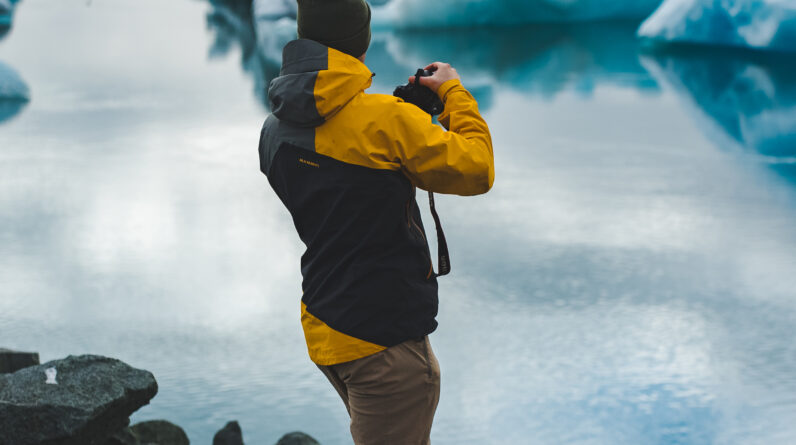
Imagine a world without kayaks, a world where the exhilarating experience of gliding through the water is unknown. Well, it all started with one innovative mind – the inventor of kayaks, whose name has become synonymous with adventure and exploration. This individual, whose identity has been lost in the annals of time, forever changed the way we interact with water. Through their ingenuity, they paved the way for countless adventurers to discover the wonders of the open sea, rivers, and lakes. The story of the inventor of kayaks is a fascinating tale of human ingenuity and the indomitable spirit of exploration.
The Origins of Kayaking
Kayaking is a fascinating water activity that has a rich history dating back thousands of years. The origins of kayaking can be traced to ancient civilizations, where people relied on this innovative mode of transportation for survival, exploration, and hunting. Let’s delve into the ancient origins of kayaking and explore how this remarkable watercraft has evolved over time.
Ancient Origins of Kayaking
The exact beginnings of kayaking are shrouded in history, but evidence suggests that indigenous Arctic populations were the first to develop and utilize kayaks. These skilled craftsmen and seafarers designed and constructed the earliest versions of kayaks using materials readily available in their environment.
First Evidence of Kayaks
The first tangible evidence of kayaks can be found in prehistoric rock art and traditional artifacts. These ancient artifacts, such as paintings and carvings, depict the use of kayaks by early cultures in their daily lives. The presence of these depictions serves as a testament to the deep roots of kayaking in ancient history.
Aleutian Kayaks
Among the early pioneers of kayaking were the Aleutian people, who lived along the Aleutian Islands of Alaska. The innovative designs and construction techniques developed by the Aleutian kayak builders had a significant influence on the evolution of kayaks. Their kayaks were characterized by remarkable stability and maneuverability, enabling them to navigate the challenging Arctic waters of their region with ease.
Kayaking in Greenland
Greenland, another region with a rich kayaking heritage, played a crucial role in the development of kayak design. The native Greenlandic people, known as the Inuit, relied heavily on kayaks for transportation and hunting in their harsh Arctic environment. The remarkable efficiency and agility of Greenlandic kayaks made them well-suited for traversing icy waters and navigating treacherous conditions.
Invention of Modern Kayaks
While kayaking had deep historical roots, it was during the 19th and 20th centuries that significant advancements revolutionized the world of kayaking. Several individuals made significant contributions to the invention and evolution of modern kayaks. Let’s explore the stories behind their innovations.
John MacGregor and the Birth of Recreational Kayaking
In the mid-19th century, a British explorer and adventurer named John MacGregor played a pivotal role in popularizing kayaking as a recreational activity. MacGregor’s passion for exploration and love for the water inspired him to develop a lightweight kayak called the Rob Roy. The Rob Roy was a folding kayak that could be easily transported and assembled, allowing enthusiasts to explore waterways and indulge in recreational kayaking.
Hans Klepper: Folding Kayaks
Another influential figure in the evolution of modern kayaks was Hans Klepper, a German inventor and boatbuilder. Klepper’s innovation lies in the development of folding kayaks, which offered enhanced portability and convenience. These collapsible kayaks, known as Klepper kayaks, enabled kayakers to easily transport their watercraft to remote and challenging locations, opening up new possibilities for adventurous exploration.
George W. Perry: Fiberglass Kayaks
In the mid-20th century, George W. Perry introduced a groundbreaking material that revolutionized kayak construction – fiberglass. Perry’s experimentation with fiberglass as a lightweight, durable, and flexible material resulted in the production of fiberglass kayaks. These kayaks offered improved performance, greater maneuverability, and increased resistance to impact and wear. The introduction of fiberglass kayaks marked a significant turning point in the evolution of kayak design.
Modern Materials and Designs
As technology and materials advanced, the possibilities for kayak design expanded. Today, kayaks are crafted using a wide range of materials such as plastic, carbon fiber, and Kevlar. These modern materials contribute to the durability, lightweight nature, and enhanced performance of contemporary kayaks. Moreover, innovative designs, such as sleek touring kayaks, agile whitewater kayaks, and stable recreational kayaks, cater to the diverse needs and preferences of kayakers.

The Influences on Kayak Design
Over the centuries, diverse influences have shaped and influenced the design of kayaks. From traditional native designs to European and American influences, as well as technological advancements, each has played a role in the evolution of this remarkable watercraft.
Traditional Native Designs
Traditional indigenous cultures, such as the Aleutians, Inuit, and other Arctic populations, initially shaped kayak design. These cultures developed kayak forms and construction techniques that ensured stability, maneuverability, and efficiency in varying water conditions. The knowledge and expertise passed down through generations laid the foundation for future innovations in kayak design.
European and American Influence
Explorers and settlers from Europe and America encountered kayaking during their expeditions and recognized its practicality and potential as a recreational activity. They brought back knowledge, ideas, and inspiration from their encounters, contributing to the broader understanding and spread of kayaking beyond the Arctic regions. This cross-cultural exchange of ideas and techniques influenced the development of kayaks in new and exciting ways.
Technological Advancements
Technological advancements have had a profound impact on kayak design. The introduction of new materials, such as fiberglass mentioned earlier, opened up possibilities for lighter, more durable, and higher-performing kayaks. Additionally, advancements in manufacturing techniques, such as injection molding, have made kayaks more affordable and accessible to a wider range of enthusiasts. Technological progress continues to drive the evolution of kayak design, pushing boundaries and expanding the capabilities of this versatile watercraft.
Kayak Innovations and Developments
As kayaking evolved, several innovations and developments have transformed this water activity. From essential safety features to new and exciting designs, let’s explore some key advancements that have made kayaking more enjoyable, convenient, and accessible.
Spray Skirts and Hatch Covers
Spray skirts and hatch covers are key components that enhance kayak performance and safety. A spray skirt is a waterproof cover worn around the waist of the kayaker, preventing water from entering the cockpit and ensuring a more comfortable and dry experience. Hatch covers, on the other hand, seal storage compartments on the kayak, protecting gear and supplies from getting wet. These innovations have significantly improved the overall kayaking experience, especially in more challenging water conditions.
Safety Features: Bulkheads and Life Jackets
Safety is of paramount importance in kayaking, and the introduction of bulkheads and life jackets has greatly enhanced the safety standards of this activity. Bulkheads are partitions or walls within the kayak that create separate compartments, preventing water from easily flooding the entire vessel in case of a capsize. Life jackets, or personal flotation devices (PFDs), provide vital buoyancy and ensure the safety of kayakers in the event of an accident or emergency. These safety features have greatly minimized risks and increased confidence among kayakers.
Pedal-Driven Kayaks
A notable innovation in recent years is the advent of pedal-driven kayaks. These kayaks feature a pedal system, similar to that in a bicycle, allowing the kayaker to propel the watercraft using leg power instead of exclusively relying on paddle strokes. Pedal-driven kayaks offer greater maneuverability, hands-free operation, and increased efficiency, making them a popular choice for anglers, photographers, and those seeking a more effortless kayaking experience.
Sit-on-Top Kayaks
Sit-on-top kayaks have gained immense popularity due to their user-friendly design and versatility. Unlike traditional kayaks that enclose the kayaker within a cockpit, sit-on-top kayaks feature an open deck where the kayaker sits on a molded seat. This design allows for easier entry and exit, increased stability, and the opportunity to enjoy swimming or snorkeling in calm waters. Sit-on-top kayaks cater to a wide range of skill levels and are particularly favored by recreational kayakers and families.
Tandem and Inflatable Kayaks
Tandem kayaks, designed for two people, have become a popular choice for couples, friends, and families who wish to share the joy of kayaking together. These kayaks offer increased stability and provide a platform for social bonding and teamwork on the water. Additionally, inflatable kayaks have gained traction as a convenient and portable option for kayakers. These kayaks can be easily deflated, folded, and stored, making them ideal for travelers, adventurers, and those with limited storage space.

Famous Kayakers
Throughout history, there have been remarkable individuals who have embraced kayaking as a way of life, pushing the limits of exploration and conservation. Let’s take a look at three notable figures who have left an indelible mark on the world of kayaking.
Paul Caffyn: The Paddling Nomad
Paul Caffyn, a New Zealand kayaker and author, is renowned for his incredible paddling feats. He became the first person to circumnavigate Australia and New Zealand by kayak, covering thousands of kilometers in arduous and often treacherous conditions. Caffyn’s endurance, resilience, and determination inspire kayakers worldwide, showcasing the immense potential for adventure that lies within the realms of kayaking.
Nigel Dennis: Designer and Explorer
Nigel Dennis, a British kayak designer and accomplished kayaker, has made significant contributions to the world of kayaking. He is celebrated for designing innovative and high-performance sea kayaks, which have won countless awards for their exceptional design and functionality. Dennis himself has embarked on daring expeditions, including a remarkable solo circumnavigation of Ireland. His designs and explorations have propelled the growth of sea kayaking as a popular water activity.
Kristine Tompkins: Conservationist Kayaker
Kristine Tompkins is a prominent conservationist and philanthropist who has integrated kayaking with her passion for wildlife preservation. Together with her late husband, Douglas Tompkins, she embarked on numerous kayaking expeditions, which solidified their commitment to conservation efforts. Their organization, Tompkins Conservation, focuses on promoting biodiversity, protecting habitats, and preserving wildlife corridors. Tompkins’ dedication to environmental conservation highlights the transformative power of kayaking in fostering a deep connection with nature.
Kayak Racing and Competitions
While kayaking serves as a recreational activity for many, it has also evolved into a competitive sport. From Olympic canoeing and kayaking to thrilling whitewater competitions and exhilarating sea kayaking races, kayaking offers a platform for kayakers to showcase their skills and athleticism.
Olympic Canoeing and Kayaking
Canoeing and kayaking have been an integral part of the Olympic Games since 1936. The sport features various disciplines, including sprint, slalom, and marathon racing. Olympic kayakers exhibit exceptional speed, agility, and endurance as they navigate through challenging courses and compete for gold, showcasing the pinnacle of competitive kayaking.
Whitewater Kayaking Competitions
Whitewater kayaking competitions are adrenaline-fueled events that pit kayakers against the roaring rapids and turbulent water currents. With a primary focus on maneuverability, athletes navigate through a series of gates and obstacles, showcasing their technical prowess and agility. These high-intensity competitions are a true test of skill, strength, and mental resilience.
Sea Kayaking Races
Sea kayaking races combine the endurance and maneuverability of kayaking with the captivating beauty of coastal and open-water environments. These races often span long distances, challenging kayakers to sustain their performance while navigating changing tides, currents, and weather conditions. Sea kayaking races provide an opportunity for kayakers to push their limits and immerse themselves in the awe-inspiring natural surroundings.

Kayaking as a Recreational Activity
Kayaking’s popularity as a recreational activity continues to grow, attracting adventure enthusiasts, nature lovers, and individuals seeking an escape from the stresses of modern life. The benefits of kayaking, coupled with the availability of various gear and equipment, make it a rewarding pastime for people of all ages and abilities.
Benefits of Kayaking
Kayaking offers numerous physical and mental health benefits. The rhythmic motion of paddling engages the upper body, core, and lower body muscles while providing a low-impact cardiovascular workout. Beyond the physical advantages, kayaking promotes mental well-being by immersing individuals in nature, reducing stress, and facilitating a sense of calm and relaxation. Furthermore, kayaking fosters a deeper connection with the environment and promotes an appreciation for the beauty and serenity of waterways.
Kayaking Gear and Equipment
The right gear and equipment are essential for a safe and enjoyable kayaking experience. Basic equipment includes a kayak, paddle, and personal flotation device (PFD), while additional gear such as spray skirts, dry bags, and waterproof clothing enhance comfort and safety. Aspiring kayakers should ensure they have appropriate gear, understand proper usage, and consider factors such as water conditions, duration of kayaking trips, and personal preferences when selecting equipment.
Popular Kayaking Destinations
The world is replete with breathtaking kayaking destinations, each offering unique landscapes and waterways to explore. From serene lakes and winding rivers to majestic coastlines and dramatic fjords, the possibilities for kayaking adventures are boundless. Popular kayaking destinations include the serene waters of Lake Tahoe in California, the stunning beauty of the Abel Tasman National Park in New Zealand, and the thrilling whitewater rapids of the Futaleufú River in Chile. Exploring these destinations allows kayakers to discover hidden gems, experience diverse ecosystems, and forge unforgettable memories.
Kayaking in Popular Culture
Kayaking’s allure extends far beyond its physical and recreational aspects. It has embedded itself in popular culture, making appearances in movies, literature, and even serving as a metaphor for life’s journeys.
Kayaking in Movies and TV
Kayaking has featured in numerous films and TV shows, showcasing the thrill and adventure associated with this water activity. From heart-pounding river paddling scenes to serene ocean expeditions, kayaking sequences have offered audiences a glimpse into the beauty and excitement of the sport. Films like “The River Wild” and “Deliverance” have captured the intensity and challenges encountered in whitewater kayaking, while documentaries such as “The Cove” have shed light on the conservation efforts intertwined with kayaking.
Kayaking in Literature
Kayaking has also made its mark in the world of literature, with authors crafting compelling narratives around this captivating water activity. Books like “The River Runners” by Louise Mahood and “Paddle to the Arctic” by Don Starkell recount extraordinary kayaking expeditions, providing readers with a window into the exhilarating world of kayak exploration. The written word has allowed kayaking enthusiasts to share their experiences, inspire others, and evoke a sense of wanderlust and adventure.
Kayaking as a Metaphor
Beyond its representations in movies and literature, kayaking has also become a powerful metaphor for life’s journeys. The act of navigating uncertain waters, overcoming obstacles, and finding balance resonates deeply with individuals facing personal challenges or embarking on new ventures. The symbolism of kayaking invites introspection, reminding us to embrace the ebb and flow of life, adapt to changing circumstances, and remain resilient in the face of adversity.
Environmental Impact and Conservation
As kayaking and outdoor recreational activities become increasingly popular, it is vital to consider the environmental impact and prioritize sustainable practices. Responsible kayaking practices can help protect waterways and ecosystems, ensuring their preservation for future generations.
Protecting Waterways and Ecosystems
Kayakers must adopt environmentally conscious practices to minimize negative impacts on waterways and ecosystems. It is crucial to respect wildlife habitats, avoid disturbing sensitive ecosystems, and adhere to guidelines and regulations set by local authorities. Additionally, participating in river and beach clean-up initiatives, supporting conservation organizations, and spreading awareness about environmental issues can contribute to the safeguarding of natural environments.
Sustainable Kayak Manufacturing
The manufacturing process of kayaks has a significant environmental footprint. However, advancements in sustainable manufacturing techniques and the use of eco-friendly materials are transforming the industry. Manufacturers are embracing greener practices, such as incorporating recycled materials, reducing waste through efficient production methods, and exploring biodegradable alternatives. By choosing kayaks made with sustainable materials, kayakers can minimize their ecological impact and support environmentally responsible practices within the industry.
Leave No Trace Principles for Kayakers
Adhering to Leave No Trace principles is essential when kayaking in natural environments. These principles advocate for leaving the outdoors as pristine as when we found it, minimizing our impact on the environment. This includes packing out all trash, disposing of human waste properly, and avoiding damage to vegetation and wildlife habitats. By embodying these principles, kayakers play a crucial role in ensuring the long-term sustainability and conservation of our natural surroundings.
Future of Kayaking
As technology and societal trends continue to evolve, the future of kayaking holds exciting possibilities. The development of innovative kayak technologies, increased accessibility and inclusivity, and the continuing evolution of designs all contribute to an optimistic outlook for the future of this water activity.
Advancements in Kayak Technology
The rapid pace of technological advancements paves the way for exciting developments in kayak design and functionality. From the integration of smart sensors and GPS tracking systems to improved navigation aids and enhanced safety features, future kayaks will undoubtedly provide kayakers with greater convenience, safety, and performance. Lightweight materials, such as carbon fiber composites, will continue to evolve, making kayaks more efficient, durable, and customizable.
Increased Accessibility and Inclusivity
Efforts to improve accessibility and inclusivity within the kayaking community are gaining momentum. The development of adaptive kayaking programs and specialized equipment, such as modified seats and paddle attachments, are enabling individuals with disabilities to engage in kayaking activities. Moreover, initiatives to make water access points more accommodating and to provide educational resources for beginners are broadening the appeal of kayaking and ensuring that everyone can experience the joy and benefits of this engaging water activity.
Continuing Evolution of Designs
Kayak designs will continue to evolve, catering to the diverse needs and preferences of kayakers. The development of hybrid kayaks that combine elements of different kayak types, such as combining sit-on-top and touring features, will offer kayakers greater versatility and adaptability. Furthermore, innovations in hull shapes, increased stability, and improved maneuverability will enhance the performance and safety of kayaks, inspiring more individuals to take up kayaking as a recreational pursuit.
In conclusion, the origins of kayaking trace back to ancient civilizations, where indigenous peoples relied on this remarkable watercraft for survival and exploration. With the passage of time, kayaking evolved, thanks to the contributions of noteworthy inventors, innovative designs, and advancements in materials and manufacturing techniques. Today, kayaking has become a beloved recreational activity, fostering a deep connection with nature and offering numerous physical and mental health benefits. It is crucial to prioritize responsible and sustainable kayaking practices to protect our waterways and ecosystems for future generations. With exciting advancements on the horizon, the future of kayaking holds tremendous potential as it continues to capture the hearts and minds of adventure seekers, nature enthusiasts, and those seeking solace on the water.









